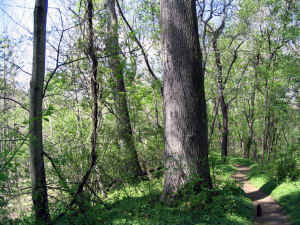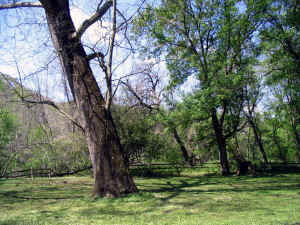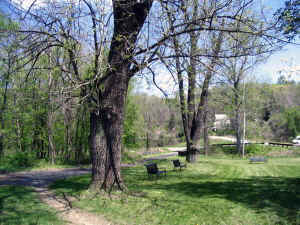Greetings!
The weather here in Maryland has been excellent for anyone who
enjoys
the outdoors, so today I decided to take my tape measure,
notebook, and
field guide to trees out into Patapsco State Park to see if I
could get
some actual numbers for the park. I focused on the lowland to
midland
areas in the Avalon area today since I am most familiar with
that
region.

The riverside tulip tree is the one that measure in at: 10'7" around.Larger tulip trees in the park seem to get up to about 10' or a bit more
in circumference, but they generally are not much bigger at this point in time.But give them a couple more decades and we'll see!
|
General Measuring Notes: All circumferences measured at 4.5
above the
ground. Heights are just estimates based on in part on what is
typical
for the species and are probably understated since Id rather
not make
claims for exceptional height that cannot be backed up with
numbers.
There was no effective way to measure the height of nearly all
of these
trees without a laser, which I do not have.
1) Box Elder (ashleaf maple): cbh = 78 height estimate =
80+
2) Box Elder (ashleaf maple): cbh = 79 height estimate =
80+

The leaning sycamore is the monster that came in at: 14'10" incircumference. This huge tree clearly grows in a relatively open area notfar from the river, which is out of the photo to the left. |
3) American Sycamore: cbh = 1410 height estimate = 100+
(huge,
significant lean)
4) American Sycamore: cbh = 81 height estimate = 90+
5) American Sycamore: cbh = 96 height estimate = 80 to
90+ (squat,
heavy limbed tree)
6) Black Locust: cbh = 411 height estimate = 60+
7) Black Locust: cbh = 77 height estimate = 70'+
8) Tulip Tree: cbh = 107 height estimate = 100+
9) Tulip Tree: cbh = 85 height estimate = 100+
10) Tulip Tree: cbh = 101 height estimate = 100+

The ash trees are the two that came in at: 10'4" and 12'8" in circumference with the larger one
in the background, though the clear bulge on the trunk from injury
increased its apparent girth at 4.5' above ground level. The even larger ash tree
is out of the photo to the left of the two smaller ones in the brush
and undergrowth. |
11) White Ash: cbh = 104 height estimate = 80+
12) White Ash: cbh = 128 (bulge at 4.5 up) height
estimate = 90+
13) White Ash: cbh estimate = 14+ height estimate = 90+
(Grows near the other 2 large green ashes, but is guarded by
poison ivy
and thorn-covered rose vines. Estimated cbh is almost 1.5 times
next
closest green ash cbh.)
14) American Beech: Estimated cbh = 9+ height estimate = 90'+
15) American Beech: Estimated cbh = 9+ height estimate = 90'+
(These 2 twin beeches are very large for the area, but grow on a
steep
slope above the river, so direct measurements of the trunks was
not
possible without a fall into the river. Estimates come from
comparing
their trunk size at a given distance to a nearby measured tulip
tree at
the same distance.)
16) White Pine: cbh = 910 height estimate = 100+
(Conifers of any size are very rare in the lowlands of the park
based on
what I have seen. Supposedly, the park has some cypress trees
and
hemlocks, but I do not know where they are located.)
17) White Oak: cbh = 71 height estimate = 80+
18) Northern Red Oak: cbh = 93 height estimate = 90+
19) Northern Red Oak: cbh = 96 height estimate = 90+
20) Hickory (believed to be Mockernut): cbh = 50 height
estimate =
70
21) Hickory (believed to be Mockernut): cbh = 71 height
estimate =
80 to 90+
22) Hickory (Shagbark): cbh = 31 height estimate = 60
23) Silver Maples: typical cbh = 9 to 12
(Accurate measurements of silver maples were very difficult
because of
underbrush and the habit this species has of branching low or
putting
out multiple trunks. The park has relatively few large silver
maples
from what I have seen.)
24) Mystery nut tree: cbh = 91 height = 80+ (suffering
limb loss;
poor health)
(This tree was a mystery. It has mottled, rough bark similar to
a silver
maple, but not as flaky, but its leaves are distinctly compound
and are
leafing out at the same type as the hickories. However, the
number of
leaflets is much higher than any other hickory Ive seen. Most
likely
match based upon the National Audubon Society Field Guide to
Trees,
Eastern Region is: a pecan, a black walnut, or a butternut.
Black walnut
is known to exist in the park based upon nuts Ive found.)
General tree notes: Tulip Trees, Sycamores and Box Elder
dominate the
lowlands, with American Beech common in the under story. Ash
trees are
also quite common. Large numbers of young silver maples were
seen in
some places. Also, a reasonable number of young hickories exist
in the
park. Very few oaks could be located in the lowland regions of
the park,
and almost no truly large ones have been measured or noted to
date; the
upland regions may be different in this regard.
|